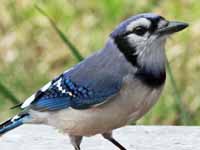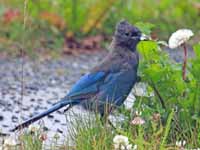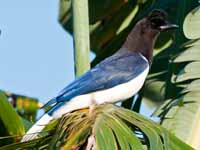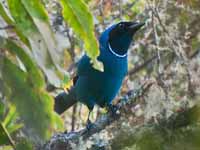BIRDS of THE WORLD - An Online Bird Book
CORVIDAE
Jays and Allies
Order Passeriformes Family Corvidae
CORVIDAE
The Corvidae family contains the crows, ravens, rooks, jackdaws, jays, magpies, treepies, choughs and nutcrackers. They are considered the most intelligent of the birds. They are medium to large in size, with strong feet and bills, and a single moult each year (most passerines moult twice). Most species have bristle-like feathers covering their nostrils. They are omnivores having a varied diet. Corvids are found worldwide except for the tip of South America and the polar ice caps. [abstracted from Wikipedia]
Jays and Allies
Order Passeriformes Family Corvidae
Genus Aphelocoma
These jays live in open pine-oak forests, chaparral, and mixed evergreen forests.They have no crest. The top of the head, nape, and sides of the head are a rich deep blue. They are found in Mexico, western United States, western Central America. Also, the Florida Scrub-Jay is found in Florida.
Jay,_California_Scrub- Aphelocoma californica Found: North America
The California Scrub-Jay has a blue head, wings, tail; gray-brown back; grayish underparts; whitish throat with blue necklace.
The Woodhouse's Scrub-Jay and the California Scrub-Jay were previously conspecific as the Western Scrub-Jay. Woodhouse's Scrub-Jay has a less distinct blue breast-band than the California Scrub-Jay. Woodhouse's tends to be inconspicuous white the California is bold and conspicuous.
Similar to: Mexican Jay. The Mexican Jay is more uniform in color; Western Scrub-Jay has a blue necklace.
Image by: 1) Becky_Matsubara - CA 2) Minette Layne - Seattle Washington 3, 4) Ted Grussing - Arizona 5) Dick Daniels - California 6) Msulis - Portland Oregon 7) Andrej_Chudy - CaliforniaThe Woodhouse's Scrub-Jay and the California Scrub-Jay were previously conspecific as the Western Scrub-Jay. Woodhouse's Scrub-Jay has a less distinct blue breast-band than the California Scrub-Jay. Woodhouse's tends to be inconspicuous white the California is bold and conspicuous.
Similar to: Mexican Jay. The Mexican Jay is more uniform in color; Western Scrub-Jay has a blue necklace.
1) Juvenile







Jay,_Florida Scrub- Aphelocoma coerulescens Found: North America
The Florida Scrub-Jay has a blue head, nape, bib, wings, tail; whitish forehead, supercilium; grayish back, underparts; black bill, legs.
Image by: 1) Andromeda 2) Btrentler 3) Mwanner 4) Glutton



Jay,_Island_Scrub- Aphelocoma insularis Found: North America (Santa Cruz Island, California)
The Island Scrub Jay has a very large biil because part of its diet is acorns.
Similar to: Western Scrub Jay. Their ranges do not overlap.
Image by: 1) Tom_Benson 2) Kevin Pietrzak 2) Bill_Bouton 3) Tony_Morris Similar to: Western Scrub Jay. Their ranges do not overlap.



Jay,_Mexican Aphelocoma wollweberi Found: North America
The Mexican Jay has a blue head, wings, tail; blue-gray mantle; pale gray underparts. From Mexico its range reaches north to eastern Arizona, western New Mexico and western Texas. Its preferred habitat is pine-oak forest.
Similar to: Transvolcanic Jay. The Mexican Jay and Transvolcanic Jay were formerly consider subspecies in the same genus. The Transvolcanic Jay is found in the Transvolcanic Belt of central Mexico. The Mexican Jay is found in northen Mexico and southwestern USA.
Similar to: Western Scrub-Jay. The Mexican Jay is more uniform in color; Western Scrub-Jay has a blue necklace
Image by: 1) Marcel Holyoak - Arizona 2) New Jersey Birds 3, 4) Alan Vernon - Arizona Similar to: Transvolcanic Jay. The Mexican Jay and Transvolcanic Jay were formerly consider subspecies in the same genus. The Transvolcanic Jay is found in the Transvolcanic Belt of central Mexico. The Mexican Jay is found in northen Mexico and southwestern USA.
Similar to: Western Scrub-Jay. The Mexican Jay is more uniform in color; Western Scrub-Jay has a blue necklace
1) Juvenile




Jay,_Transvolcanic Aphelocoma ultramarina Found: central Mexico
The Mexican Jay and Transvolcanic Jay were formerly consider subspecies in the same genus. The Transvolcanic Jay is found in the Transvolcanic Belt of central Mexico. The Mexican Jay is found in northen Mexico and southwestern USA.
Image by: 1, 2) Amy McAndrews - Veracruz1) Juvenile


Jay,_Unicolor Aphelocoma unicolor Found: Mexico, Central America
The Unicolor Jay has dark blue plumage; black lores; long tail; heavy bill.
Image by: 1) Francesco Veronesi - Mexico 2) Sergey Yeliseev - Mexico 3) Francesco_Veronesi 4) Nick Athanas 



Jay,_Woodhouse's_Scrub- Aphelocoma woodhouseii Found: southeastern Oregon to central Mexico
The Woodhouse's Scrub-Jay and the California Scrub-Jay were previously conspecific as the Western Scrub-Jay. Woodhouse's Scrub-Jay has a less distinct blue breast-band than the California Scrub-Jay. Woodhouse's tends to be inconspicuous white the California is bold and conspicuous.
Woodhouse's Scrub-Jay has the subspecies Sumichrast's scrub jay (Aphelocoma woodhouseii sumichrasti) that may be split into seperate species.
Image by: 1) Jerry Oldenettel - New Mexico 2) Peter_Wallack- New Mexico 3) Tony_Randell - UtahWoodhouse's Scrub-Jay has the subspecies Sumichrast's scrub jay (Aphelocoma woodhouseii sumichrasti) that may be split into seperate species.



Genus Calocitta
The two mappie-jay species both have black sparce crests. They live in southern North America.
Jay,_Black-throated Magpie- Calocitta colliei Found: Mexico
The Black-throated Magpie-Jay has blue upperparts; white underparts; black throat, head, crest, bill, legs; pale blue spot over eye; pale blue patch under eye.
Similar to: White-throated Magpie-Jay. They are know by their faces.
Image by: 1) Dick Daniels - National Aviary 2) fredhochstaedter 3) Jorge_MontejoSimilar to: White-throated Magpie-Jay. They are know by their faces.



Jay,_White-throated_Magpie- Calocitta formosa Found: Mexico, Central America
The White-throated Magpie-Jay has white face, underparts; blue upperparts, tail; black crest, legs; gray bill.
Similar to: Black-throated Magpie-Jay. They are know by their faces.
Image by: 1) Jerry Oldenettel 2) Dominic Sherony 3) Hans_Norelius 4) Nick Athanas - Mexico 5) Maris_Pukitis Similar to: Black-throated Magpie-Jay. They are know by their faces.





Genus Cyanocitta
This genus contains the Blue Jay and Steller's Jay. They are both North American crested jays.
Jay,_Blue Cyanocitta cristata Found: North America
The Blue Jay has blue upperparts; off-white underparts; blue tail barred with black, black collar, eye-line. It has a crest which is raised or lowered depending on the mood.
Image by: 1, 2, 4, 5, 6, 7. 8) Dick Daniels - North Carolina 3) Rich Leche 8) Blue Jay with Red-bellied Woodpecker








Jay,_Steller's Cyanocitta stelleri Found: western North America
The Steller's Jay has blackish-brown head, neck; silvery-blue lower breast, belly; blue wings, tail, flanks.
Image by: 1, 2, 3) Alan D Wilson - British Columbia 4. 5) Dick Daniels - Seward, Alaska 6) Charlie Westerinen - central Sierra Nevada





Genus Cyanocorax
This genus contains several closely related species that primarily are found in wooded habitats of Mexico and Central and South America, with the Green Jay just barely entering the United States. The upperparts (except for the Green Jay) are primarily blue or purplish.
Jay,_Azure Cyanocorax caeruleus Found: mainly southeast Brazil, also northeast Argentina, eastern Paraguay
The Azure Jay has mainly blue plumage; black head, neck, upper-breast.
Image by: 1) Aaron Maizlish - Brazil 2) Vinivinizinho 3) Cornell_Univ's_Neotropical_Birds_Online - Steven Whitebread 4) Lotlhmoq 



Jay,_Azure-naped Cyanocorax heilprini Found: Brazil, Columbia, Venenzuela
The Azure-naped Jay has mainly dark purple-gray plumage; light blue crown, nape; blue malar; yellow eyes; white under-tail.
Image by: 1) Cornell_Univ's_Neotropical_Birds_Online - Joao_Quental 2) Nick Athanas - Columbia

Jay,_Black-chested Cyanocorax affinis Found: Costa Rica, Panama, Columbia, Venezuela
The Black-chested Jay has dark violet-blue upperparts, wings; mostly black head, face, breast; violet-blue patch above eye and malar stripe; white lower-breast, belly.
Image by: 1) Felix_Uribe - Columbia 2) Nick Athanas - Panama, Columbia 3) Neil Orlando Diaz Martinez 


Jay,_Bushy-crested Cyanocorax melanocyaneus Found: Central America
The Bushy-crested Jay is found in El Salvador, Guatemala, Honduras, and Nicaragua.
Image by: 1) Cornell_Univ's_Neotropical_Birds_Online-Yeray_Seminario 2) Dominic
Sherony

Jay,_Cayenne Cyanocorax cayanus Found: northern Brazil, the Guianas, eastern Venezuela
The Cayenne Jay has dark brownish-purple back; whitish rear crown, nap,; lower-breast, belly; black fore-crown, face, throat, upper-breast.
Image by: 1) Barloventomagico 2) EtienneLFR 3) Tony_Morris - Venezuela


Jay,_Curl-crested Cyanocorax cristatellus Found: South America
The Curl-crested Jay has blackish back, head, neck; white underparts; black curl crest rising from just behind the bill.
Similar to: Plush-crested Jay. Crest of Curl-crested Jay emanates from just behind bill; crest of Plush-crested Jay extends behind the head. Plush-crested Jay has blue arc over eye.
Image by: 1, 2, 3)
Dario Sanches - Brazil 4) Nick Athanas - Brazil 5) JairmoreirafotografiaSimilar to: Plush-crested Jay. Crest of Curl-crested Jay emanates from just behind bill; crest of Plush-crested Jay extends behind the head. Plush-crested Jay has blue arc over eye.





Jay,_Green Cyanocorax yncas Found: North America (Texas), Central and South America
The Green Jay has green upperparts; yellow to green underparts; blue crown, nape; black bib continues up side of head.
Image by: 1) Dick Daniels - San Francisco Zoo 2) Juan Tello- Venezuela 3) Charlie Westerinen - Texas 4) Alan
D Wilson - Texas 5) Andy_Morffew 6) Nick Athanas - Ecuador 





Jay,_Plush-crested Cyanocorax chrysops Found: South America
The Plush-crested Jay has bluish-gray upperparts; black head; black plusy crest; black nape, bib; yellowish-white lower breast, belly; blue arc over eye.
Similar to: Curl-crested Jay. Crest of Curl-crested Jay emanates from just behind bill; crest of Plush-crested Jay extends behind the head. Plush-crested Jay has blue arc over eye.
Image by: 1) David Monniaux Iguazú National Park (Argentina) 2) Sandy Cole - San Diego
Zoo 3) Dario Sanches - Brazil 4) Nick Athanas - ArgentinaSimilar to: Curl-crested Jay. Crest of Curl-crested Jay emanates from just behind bill; crest of Plush-crested Jay extends behind the head. Plush-crested Jay has blue arc over eye.




Jay,_Purplish Cyanocorax cyanomelas Found: South America
The Purplish Jay has dull purple upperparts; black head, neck.
Image by: 1) J Quental - Brazil 2) Hector Bottai - Brazil 3, 4) Nick Athanas - Brazil 5) Dominic Sherony - Peru




Jay,_Purplish-backed Cyanocorax beecheii Found: Mexico
The Purplish-backed Jay has deep blue to purple upperparts; black bill, head, neck, underparts; yellow eyes, legs.
Similar to: San Blas Jay. San Blas Jay has lighter upperparts than Purplish-backed Jay.
Image by: 1) Amy McAndrews 2, 3) Cburnett 4) Ron_Knight Similar to: San Blas Jay. San Blas Jay has lighter upperparts than Purplish-backed Jay.




Jay,_San Blas Cyanocorax sanblasianus) Found: Mexico
The San Blas Jay has blue upperparts; black head, nape, underparts.
Similar to: Purplish-backed Jay. San Blas Jay has lighter upperparts than Purplish-backed Jay.
Image by: 1, 2) Kurayba 3) Kurt_BauschardtSimilar to: Purplish-backed Jay. San Blas Jay has lighter upperparts than Purplish-backed Jay.



Jay,_Tufted Cyanocorax dickeyi Found: Mexico
The Tufted Jay has dark blue upperparts; dark blue top half of tail; white nape, underparts, bottom half of tail.
Image by: 1) Ron Knight 2, 3) Francesco Veronesi 4) Bryant_Olsen



Jay,_Violaceous Cyanocorax violaceus Found: South America
The Violaceous Jay has dull violet upperparts; lighter nape; black throat, head; pale violet underparts.
Image by: 1) Joao Quental - Venezuela 2) Geoff Gallice 3) Nick Athanas - Ecuador


Jay,_White-naped Cyanocorax cyanopogon Found: Brazil
The White-naped Jay has mainly brown upperparts; white nape, underparts; black head, throat, upper-breast.
Image by: 1) Claudio_Timm 2) Shanthanu Bhardwaj 3) Nick Athanas - Brazil


Jay,_White-tailed Cyanocorax mystacalis Found: Ecuador and Peru
The White-tailed Jay has dark blue back, wings; black head with small white patch above eyes and large white patch below eyes; black bib; white rest of underparts, tail.
Image by: 1) David Cook - Peru 2) Nick Athanas - Peru 3, 4) Francesco_Veronesi - Ecuador



Jay,_Yucatan Cyanocorax yucatanicus Found: Belize, Guatemala, Mexico
The Yucatan Jay has blue upperparts; black head, nape, underparts;
Image by: 1) Tony Hisgett - Mexico 2) Scott Reader 3) Kyla 4) Jean-Sebastien_Guenette - Mexico



Genus Cyanolyca
All are largely blue and have a black mask. They also possess black bills and legs and are skulking birds. They are found in Central America and South America.
Jay,_Azure-hooded Cyanolyca cucullata Found: Mexico, Central America
The Azure-hooded Jay has mainly dark blue plumage; black head with sky blue back of the head and neck. The blue patch can have a white border.
Image by: 1) Toter_Alter_Mann 2) Hans Zwitzer - Costa Rica 3) David Rodriguez - Costa Rica 4) Cephas - Costa Rica



Jay,_Beautiful Cyanolyca pulchra Found: Columbia, Ecuador
The Beautiful Jay has mainly dark blue plumage; black face, forehead; whitish crown.
Image by: 1) Elisa Bonaccorso 2) Michael Woodruff 3) Nick Athanas - Ecuador 4) Cornell_Univ's_Neotropical_Birds_Online - Andrew_Spencer in Ecuador Luis Mejia 



Jay,_Black-collared Cyanolyca armillata Found: Columbia, Ecuador. Venezuela
The Black-collared Jay has mainly blue plumage; paler blue crown; black mask, collar.
Similar to: Turquoise Jay. The Turquoise Jay has a greener tinge than the Black-collared Jay and a narrower mask.
Image by: 1) Elisa Bonaccorso 2, 4) Felix_Uribe - Columbia 3) Sebastian Davila Similar to: Turquoise Jay. The Turquoise Jay has a greener tinge than the Black-collared Jay and a narrower mask.




Jay,_Black-throated Cyanolyca pumilo Found: Mexico, Central America
The Black-throated Jay has mainly dark blue plumage; black face; narrow white upper border to the black face.
Image by: 1) Toter_Alter_Mann 2) Dominic Sherony - Guatemala

Jay,_Dwarf Cyanolyca nana Found: Mexico
The Dwarf Jay is a small, dull blue jay. It also has a black mask on the face, and the throat is pale blue. Although it can be locally common, this jay has a small distribution in the mountains of southeastern Mexico
Image by: 1) Toter_Alter_Mann 2) Jerry Oldenettel - Oaxaca 3) Nick Athanas


Jay,_Silver-throated Cyanolyca argentigula Found: Costa Rica, Panama
The Silver-throated Jay has mainly dark blue plumage; silvery throat patch, supercilium.
Image by: 1) Toter_Alter_Mann 2) John Gerrard Keulemans 3) Dominic Sherony - Costa Rica


Jay,_Turquoise Cyanolyca turcosa Found: Columbia, Ecuador, Peru
The Turquoise Jay has mainly blue plumage; black face mask, collar
Similar to: Black-collared Jay. The Turquoise Jay has a greener tinge than the Black-collared Jay and a narrower mask.
Image by: 1) Elisa Bonaccorso 2) Ted Boniecki - Ecuador 3) David Cook - Ecuador 4, 5) Nick Athanas - Ecuador 6) Nomdeploom - EcuadorSimilar to: Black-collared Jay. The Turquoise Jay has a greener tinge than the Black-collared Jay and a narrower mask.






Jay,_White-collared Cyanolyca viridicyanus Found: Bolivia, Peru
The White-collared Jay has mainly blue-green plumage; black face mask, under-tail; white forehead, collar.
Image by: 1) Elisa Bonaccorso 2) Claudio Timm 3, 4) Cornell_Univ's_Neotropical_Birds_Online - Daniel_Lane in Bolivia, Paul_Fenwick in Peru



Jay,_White-throated Cyanolyca mirabilis Found: Mexico
The White-throated Jay has mainly slate-blue plumage; mainly black head; white supercilium extending beyond ear-coverts; white throat.
Image by: 1) Toter_Alter_Mann 2) Ryan Shaw

Genus Garrulus
Jay,_Black-headed Garrulus lanceolatus Found: Asia
Similar to: The Eurasian Jay has a black head; the Eurasian Jay does not have a black head.
Image by: 1) Allan Hopkins - India 2) Shrikant_Rao - India 3) Koshy_Koshy - India 4) Soumendu_Das 5) Srikaanth_Sekar 




Jay,_Eurasian Garrulus glandarius Found: Europe, Asia, Africa
The Eurasian Jay has pinkish-gray to reddish-brown upperparts; white throat, rump; black tail, moustache stripe.
Similar to: The Black-headed Jay has a black head; the Eurasian Jay does not have a black head.
Image by: 1) Donkey_shot Aviad Bublil - Israel 2, 3)_Luc
Viatour 4) Andrej_Chudy - Sloviakia 5) outnaboutwithcamera - England 6) Pete_Beard 7) Cristiano Crolle - ItalySimilar to: The Black-headed Jay has a black head; the Eurasian Jay does not have a black head.







Jay,_Lidth's Garrulus lidthi Found: Japan
The Lidth's Jay has mainly chestnut-purple plumage; velvety black head; purplish-blue nape and upper-back.
Image by: 1) MaterialScientist
Genus Gymnorhinus - 1 species
Jay,_Pinyon Gymnorhinus cyanocephalus Found: Western North Amerca
The Pinyon Jay is bluish-gray with deeper head coloring; light throat; black bill, legs.
Image by: 1) Charle Westerinen near Cortez, Colorada 2, 3) Alan D Wilson - Oregon 4) Jerry_Oldenettel - New Mexico



Genus Nucifraga
The bills of nutcracker are specialized tools for extracting seeds from pine cones.
Nutcracker,_Clark's Nucifraga columbiana Found: North America
Clark's Nutcracker
has a gray body with black wings and tail; white rump; black biil, feet.
Similar to: Gray Jay. Clark's Nutcracker has black on wings; Gray Jay does not. Gray Jay has dark nape; Clark's Nutcracker has light colored nape.
Image by:
1) Alan D Wilson - Oregon
2) Eugene_Beckes 3) Donald_Hobern - Colorado 4) Aaron_Maizlish - NevadaSimilar to: Gray Jay. Clark's Nutcracker has black on wings; Gray Jay does not. Gray Jay has dark nape; Clark's Nutcracker has light colored nape.




Nutcracker,_Kashmir also Large_Spotted Nutcracker Nucifraga multipunctata Found: western Himalayas
Image by: 1) John_Gould

Nutcracker,_Spotted also Eurasian Nutcracker Nucifraga caryocatactes Found: Europe, Asia
The Spotted Nutcracker is mainly chocolate brown with white spots and white streaks. The wings and upper tail are blackish.
Image by: 1 ) Staszek99 2) MurrayBHenson - Poland 3) Arto_Huotari - Finland 4) Aaron_Maizlish - Switzerland



Genus Perisoreus
The gray jays. All three species store food and live year-round on permanent territories in coniferous forests.
Jay,_Gray Perisoreus canadensis Found: North America
The Gray Jay has dark gray upperparts; dark rear of head, light gray underparts; light fore-crown, neck, upper breast.
Similar to: Clark's Nutcracker. Clark's Nutcracker has black on wings; Gray Jay does not. Gray Jay has dark nape; Clark's Nutcracker has light colored nape.
Image by: 1) Ken Clifton - Oregon 2) Seabamirum 3, 4, 5, 6, 7) Dick Daniels - Wonder Lake, Denali National Park 8) Cephas - Quebec, CanadaSimilar to: Clark's Nutcracker. Clark's Nutcracker has black on wings; Gray Jay does not. Gray Jay has dark nape; Clark's Nutcracker has light colored nape.
1) Light juvenile 2) Dark Juvenile








Jay,_Siberian Perisoreus infaustus Found: northern Asia and northern Europe
The Siberian Jay is a very inquisitive and fearless species, which can be seen near camps and fires, and which will even take food if some is left nearby.
Image by: 1) Daniel Pettersson 2) Martha de Jong-Lantink 3, 4) Estormiz - Finland



Jay,_Sichuan Perisoreus internigrans Found: northern China
Like the other members of Perisonreus, the Sichuan Jay does not migrate. It survives the cold winters by eating food it previously stored.
Image by:
1) Unknown 2) Tang Jun 3) Jame Eaton - Sichuan


Genus Platylophus - 1 species
Jay,_Crested Platylophus galericulatus Found: southeast Asia, Indonesia, Malaysia
The Crested Jay is traditionally placed in the family Corvidae but might belong to the helmetshrikes of family Prionopidae.
Image by:
1) Roland_Adams 2) Doug Janson - Jurong Bird Park, Singapore 

Genus Podoces
The ground-jays inhabit high altitude semi-desert areas from central Asia to Mongolia. Theys show adaptations to ground living such as long, strong legs adapted to fast running and the ability to leap and bound onto boulders and rocks with great agility. Their long, curved thick bills are adapted for digging and probing. While capable of flight (which they do infrequently and relatively weakly), they prefer running, and will readily perch on trees and bushes also.
Jay,_Mongolian Ground- also Henderson's Ground-Jay Podoces hendersoni Found: Mongolia, China, Kazakhstan, and Russia
The Mongolian Ground-Jay has mainly tan plumage; black and blue on flight feathers; black forehead; relatively long and curved bill.
Image by: 1) Jargal Lamjay 2) Sergey_Pisarevskiy

Jay,_Pleske's Ground- also Iranian Ground-Jay Podoces pleskei Found: Iran
Image by: 1) Amir Hossein

Jay,_Turkestan Ground- also Pander's Ground-Jay Podoces panderi Found: central Asia
The Turkestan Ground-Jay has blue-gray upperparts; tan underparts; black upper-breast patch, uppertail.
Image by: 1) Alastair Rae 2) Francesco Veronesi - Uzbekistan

Jay,_Xinjiang Ground- also Biddulph's Ground-Jay Podoces biddulphi Found: China
The Xinjiang Ground-Jay has mainly light brown plumage; black crown, cheek patch blackish throat; long and curved bill.
Image by: 1) John Gerrard Keulemans 2) P_Khoo 3) Chong Qing Ka


Genus Psilorhinus - 1 species
Jay,_Brown Psilorhinus morio Found: North America (southern Texas), Central America
The Brown Jay comes in two types. Northern birds have dark brown upperpart; light brown underparts. Southern birds have white bellies.
Image by: 1) rob Stoeltje 2) Dominik Hoter - Costa Rica
3) Carol Foil - Costa Rica 4) Nick Athanas - Costa Rica 5) Chara_Papan1) Juvenile





Genus Ptilostomus - 1 species
Piapiac Ptilostomus afer Found: tropical Africa
The Piapiac has mainly black plumage; brownish-black tail; black bill, legs.
Image by: 1) Dick Daniels - specimen in Nairobi National Museum, Kenya 2) JV Verde - Gambia 3) Thomas Brown - Gunjur, Gambia

